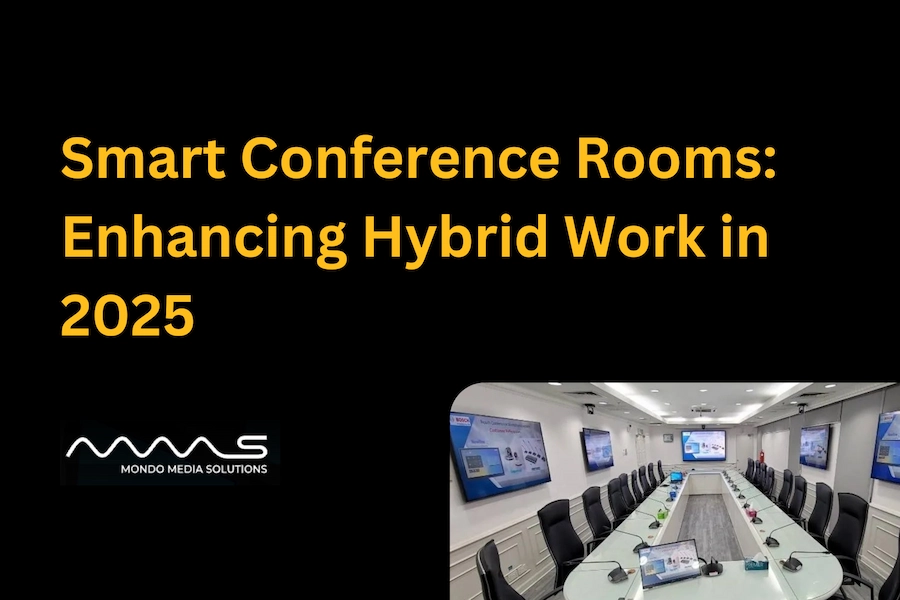The workplace has undergone a significant transformation, with hybrid work models becoming the norm. As organizations adapt to this new reality, the need for intelligent collaboration environments has never been greater. Enter smart conference room solutions—the key to unlocking productivity and seamless communication in 2025.
These advanced meeting spaces integrate cutting-edge technologies to bridge the gap between remote and in-person teams, ensuring that collaboration remains efficient and effective regardless of location.
What are Smart Conference Rooms?
Smart conference rooms are technologically enhanced meeting spaces designed to facilitate seamless communication and collaboration. They incorporate automation, integration, and real-time connectivity to create an environment where meetings are more productive and engaging.
Core Features:
- Automation: Automated controls for lighting, temperature, and equipment setup streamline meeting preparation.
- Integration: Seamless integration with calendars, communication platforms, and other business tools simplifies scheduling and participation.
- Real-Time Connectivity: High-speed internet and advanced AV technology ensure smooth, uninterrupted communication.
For distributed teams, smart conference rooms are essential in maintaining a cohesive work environment, enabling real-time collaboration regardless of physical location.
Top Features Powering Smart Conference Room Solutions
The effectiveness of smart conference room solutions lies in their advanced features, which cater to the dynamic needs of modern workplaces:
- AI-Driven Scheduling and Voice Control: Artificial intelligence simplifies meeting scheduling and allows for hands-free operation of room features through voice commands.
- Wireless Presentation Systems and Screen Sharing: Eliminate the clutter of cables with wireless solutions that enable easy sharing of presentations and documents.
- Unified Communication Platforms: Integration with platforms like Zoom and Microsoft Teams ensures consistent communication experiences.
- Simplified Device Management: Centralized control systems allow IT teams to manage and troubleshoot equipment remotely, reducing downtime.
These features collectively enhance the functionality of smart conference rooms, making them indispensable in the hybrid work era.
The Role of Smart Conference Rooms in Hybrid Work
In a hybrid work model, the challenge lies in ensuring that remote and in-office employees can collaborate effectively. Smart conference rooms address this by providing:
- Enhanced Collaboration: High-quality audio and video ensure that all participants can engage fully, regardless of location.
- Seamless Integration with Digital Tools: Compatibility with digital signage, desk booking systems, and analytics platforms streamlines operations.
- Improved Meeting Equity: Features like AI-powered cameras and microphones ensure that every participant is seen and heard clearly.
By addressing these aspects, smart conference rooms become pivotal in fostering an inclusive and productive hybrid work environment.
Real-World Applications and Benefits
The implementation of smart conference room solutions yields tangible benefits across various industries:
- Increased Meeting Efficiency: Automated setups and intuitive controls reduce time spent on technical issues.
- Reduced IT Friction: Remote management capabilities minimize the need for on-site technical support.
- Better Space Utilization: Analytics provide insights into room usage, informing decisions on space allocation and design.
For example, the Please Touch Museum Conference Room Upgrade project showcased how integrating smart technologies can revitalize meeting spaces, leading to enhanced collaboration and visitor engagement.
Future Outlook
Looking ahead, smart conference room technology is poised to incorporate even more advanced features:
- Augmented and Virtual Reality (AR/VR): Immersive technologies will enable more interactive and engaging remote meetings.
- Real-Time Language Translation: Breaking down language barriers will facilitate more inclusive global collaboration.
- Sustainability Tracking: Monitoring energy usage and other environmental metrics will support corporate sustainability goals.
These advancements will further solidify the role of smart conference rooms as essential components of the modern workplace.
Investing in smart conference room solutions is not just about keeping up with technology; it’s about future-proofing your organization’s ability to collaborate effectively in an ever-evolving work landscape. By embracing these innovations, businesses can ensure that their teams remain connected, productive, and engaged, no matter where they are.
